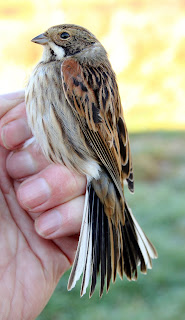Two days of rain and gales aren't the best motivation for birding, photography or ringing, so the bins haven’t had an outing for 2 days. I couldn’t even have a swim yesterday when the pool was closed because a risk assessment said the glass roof over the water was a hazard in the gales that battered the promenade building. So I crossed the road to Roger's for a haircut, and for anyone that's been there and done that, they will know it's infinitely more dangerous than a bit of flying glass.
Sat at home without blog material I waited until today when the wind lessened and I decided to go out birding with the camera for a few hours.
Knott End is something of a joke to folk around the Fylde, a bit of a one horse village where time stands still, a place where old codgers retire to their semi-detached bungalows and wait for the Grim Reaper to call by. But here’s where you can still buy nails by weight, bread from a baker, meat from a butcher, or if you like, just sit on a bench and watch the world go by. And as I’ve said before, KE can cut the mustard for a bit of leisurely, undemanding birding. It wasn’t the brightest of mornings as I watched the Oystercatchers walking the beach and a couple of Little Egrets feeding in the shallows amongst the Redshanks and Black-headed Gulls. Strangely I could find only a single Twite today, one that sported both metal and coloured rings, and now I understand why photographers aren’t fans of birds wearing rings.




Wheel Lane beckoned where I negotiated the flooded road, parked up in the gateway and looked across the flooded stubble. There was a terrific selection of somewhat distant but also numerous birds this morning: 220 Golden Plover, 520 Lapwing, 80 Redshank, 30 Dunlin,6 Snipe, 2 Black-tailed Godwit, 6 Curlew, a single Ruff and 15 Skylark. Most of the Whooper Swans were out on the marsh with a small gang of 33 on the stubble as yet others flew over heading inland.


There were waders on the wet fields at Damside too, more Lapwing, Golden Plover and Redshank, but because they were just the other side of Broadfleet where I had just counted, I didn’t add more to the totals. Chaffinch and Blackbird alarm calls from the nearby trees alerted me to the presence of a Kestrel at the top of a telegraph pole, but as the Kestrel flew off the alarms continued. Almost out of my view a Little Owl sat motionless on a branch and rather than disturb it, I let it be and drove off towards Lane Ends as the Chaffinch continued to scold the owl.
Lane Ends produced a few bits and pieces, 18 to 20 Chaffinch attracted in by the abundance of seed left by local animal lovers, 1 Treecreeper, 2 Goldcrest, 6 Blackbird and at least 10 Long-tailed Tits.

Not much on the pools either, 1 Cormorant on the big pool and 1 Goldeneye on the hidden pool, with 3 Little Egret and 1 Grey Heron out on the marsh.



























































.jpg)











